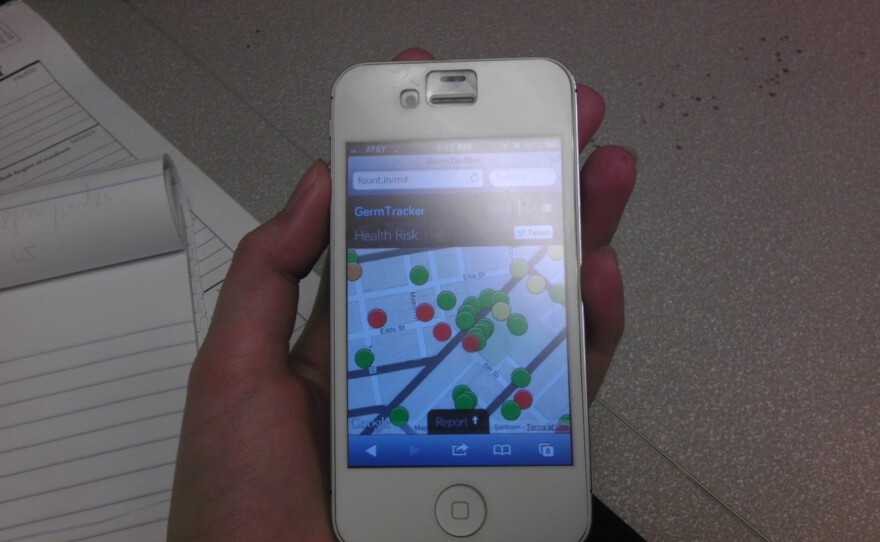Imagine using your smart phone to avoid getting the flu. A new mobile app designed by researchers at the University of Rochester could make it possible.
The app sifts through twitter feeds and alerts users to who around them might be contagious.
The Germ Tracker app is the brain child of Adam Sadilek, a post-doctoral fellow at the University of Rochester who has taught a computer program to ‘read’ twitter messages, and use GPS tracking to predict where infection may occur.
Twitter is already used to communicate with friends, interact with celebrities, and build social lives online.
But, Sadilek is set on using the popular site to track disease outbreaks instead.
“There is really no product like this that enables you to understand how these millions of people feel every second, because they self-report on their activities and they self-report on their health,” Sadilek says.
How it works
Most people in Twitter have an open profile which means their feeds are available to anyone, including researchers like Sadilek.
The Germ Tracker program sifts through the tweets looking for words and phrases that might indicate a flu-like illness.
It has been taught to look at an entire tweet instead of individual words, so it knows tweets that say things like - “I’m sick of the Government” - do not indicate a physical illness, and Sadilek says it’s getting pretty good.
“It has about 2 million features that it considers for one sentence. So it has a giant checklist of things to look for. Is this phrase here, did they use slang, and then based on the evaluation, it decides what is the probability of sickness.”
But, for the app to really be useful, tweeters enable the GPS on their computer or mobile device, because that’s how Germ Tracker is able to plot their location on a map.
The idea is to be able to track the spread of infectious diseases based on the location of users, and their interactions in the community.
“So you can see your location in the center of the screen and then the twitter users colored from red to green – from sick to healthy. And then you see immediately who has been around you, if they tweeted recently, and then you can click on these individuals and see what they tweeted about.”
Red dots on the map represent people the algorithm has labeled as sick, and green dots are people who are healthy, or just not tweeting about their health.
There is also a whole color spectrum in-between that indicates the tweets were ambiguous, or the person is not as contagious as someone who is depicted in red.
If you click on a red dot you might get something like this:
“So let’s see,” Sadilek says, “Let’s pick a random person, so this individual says ‘seriously, the stomach flu really sucks’.”
Does Germ Tracker work?
Sadilek concedes that the program isn’t perfect; he says people using twitter tend to be younger, and not everyone tweets about their health.
But, he says it’s still the first model to give real-time data at such a fine level, and it has one unique quality: the information it generates can lead users to modify their behavior and potentially avoid illness.
“It could be scary, it is. But at the same time it’s interesting because I would rather be informed.”
“Things are happening, you don’t see them, but they’re still affecting you. I would rather know. Maybe it’s depressing but at least you can adjust your behavior.”
The Centers for Disease Control says it recognizes using social media for data collection has huge potential, but so far it hasn’t developed any policies about using that kind of information.
Physician Louis Papa says the app could allow public health organizations to track where large-scale epidemics begin and what sort of interactions cause them to spread.
“So if you can imagine, if we had something like bird flu, or we had an outbreak of cholera or something like that, the social media can be a huge tool to say ‘how can we isolate this?, where did it originally start, and where is it traveling to. I mean, I think that can be enormously helpful.”
Adam Sadilek says this is the next big step for him. He wants to be able to link the interactions of sick and healthy users to generate data on the probability of infection.
The end goal for Sadilek is a smart phone that could warn you how likely you are to catch the flu if you spend time in a certain building or take the 7.15 am bus to work.
“So imagine you are on a bus, the phone vibrates and says you know if you get off this bus at the next stop, your probability of catching a cold is relatively low, but if you stay for another 10 minutes, it will go above 70 percent. And we can do this because we can anticipate who is likely to board the bus based on where they have been, and their routines." Sadilek says.
“So this sounds sci-fi, but now it’s actually possible in places that have a lot of twitter activity.”
The app is available for mobile devices across the U.S, but Sadilek says the project is still in the beta stage.
He says users can rate how well their program has classified each tweet in the app, and this feedback will help with the next stage of development.









